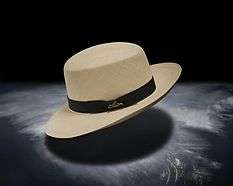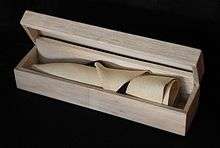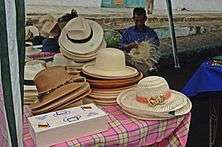Panama hat
For the Russian military hat see: Panamanka


A Panama hat (toquilla straw hat) is a traditional brimmed straw hat of Ecuadorian origin. Traditionally, hats were made from the plaited leaves of the Carludovica palmata plant, known locally as the toquilla palm or jipijapa palm,[1] although it is a palm-like plant rather than a true palm.
Panama hats are light-colored, lightweight, and breathable, and often worn as accessories to summer-weight suits, such as those made of linen or silk. Beginning around the turn of the 20th century, panamas began to be associated with the seaside and tropical locales.
The art of weaving the traditional Ecuadorian toquilla hat was added to the UNESCO Intangible Cultural Heritage Lists on 6 December 2012.[2] Panama hat is an Intangible Cultural Heritage, a term used to define practices, traditions, knowledge and skills communities pass down from generation to generation as part of their cultural heritage.[3]
History
Beginning in the early to mid-1600’s hat weaving evolved as a cottage industry all along the Ecuadorian coast as well as in small towns throughout the Andean Mountain Range. Hat weaving and wearing grew steadily in Ecuador through the 17th and 18th centuries. Even then, the best quality hats were being made in what is now the province of Manabí.[4] One of the first towns to start weaving the hats in the Andes is Principal, part of the Chordeleg Canton in the Azuay province. Straw hats woven in Ecuador, like many other 19th and early 20th century South American goods, were shipped first to the Isthmus of Panama before sailing for their destinations in Asia, the rest of the Americas and Europe, subsequently acquiring a name that reflected their point of international sale, "Panama hats", rather than their place of domestic origin.[5] The term was being used by at least 1834.[1]
The popularity of the hats was increased in the mid-nineteenth century by the miners of the California Gold Rush, who frequently traveled to California via the Isthmus of Panama. In 1904, U.S. President Theodore Roosevelt visited the construction site of the Panama Canal, and was photographed wearing a Panama hat, which further increased the hats' popularity. The hats were later worn by many early-twentieth century film stars during films.
- Tamsui hat
The tamsui hat was a straw hat made in Formosa (now Taiwan) to directly compete with the Panama in the early twentieth century.[6][7] Tamsui hats were made from Pandanus odorattssimus fibre, which grew plentifully on the island.[7] As they retained their whiteness, were washable, and could be folded and carried about without damage, Tamsui hats replaced the rather costlier Panama in the far East in the early twentieth century.[7]
Quality


The two main processes in the creation of a Panama hat are weaving and blocking. The weavetypes are the classic Cuenca/Llano herringbone in design, using a little more straw, and marginally heavier than Brisa Panamas (few miligrammes!)- tighter) and Brisa little diamonds/squares, less intricate in design (in-and-out / weft-and-waft weave), but perceived as finer than Cuenca weave by some as it is lighter. Crochet Toquilla straw is crocheted, as if it were a thread, making for a more robust and hardy finish, Fancy often using different coloured straws and different weave techniques, the straw is layered or stitches missed out in order to make textures and patterns.[8] and Torcido, New Order.[9] Hats are commercially graded with numeric degrees to indicate quality, but these vary by seller.[10] The best quality hats are known as Montecristis, after the town of Montecristi, where they are produced.[11] The Montecristi Foundation has established a grading system based on a figure called the Montecristi Cuenta, calculated by measuring the horizontal and vertical rows of weave per inch.[10] The rarest and most expensive Panama hats are hand-woven with up to 3000 weaves per square inch.[12] In February 2014, Simon Espinal, an Ecuadorian 47-year-old Panama hat weaver considered to be among the best at his craft, set a world record by creating a Panama hat with four thousand weaves per inch that took eight months to handcraft from beginning to end.[12]
According to popular lore, a "superfino" Panama hat can hold water and, when rolled up, pass through a wedding ring.[13]
Although the Panama hat continues to provide a livelihood for thousands of Ecuadorians, fewer than a dozen weavers capable of making the finest "Montecristi superfinos" remain. Production in Ecuador is dwindling, due to economic problems in Ecuador and competition from Chinese hat producers.[14]
See also
References
- 1 2 "Panama hat, n.". Oxford English Dictionary. Retrieved 2012-02-21. (subscription required)
- ↑ "Traditional weaving of the Ecuadorian toquilla straw hat". UNESCO. Retrieved 24 April 2014.
- ↑ "The Panama Hat, A Legend, a Lifestyle". Retrieved 7 April 2015.
- ↑ "A Short History of the Panama Hat". Retrieved 7 April 2015.
- ↑ Miller, Tom (1986). The Panama Hat Trail. p. 1.
- ↑ Lewandowski, Elizabeth J. The complete costume dictionary. Lanham, Md.: Scarecrow Press, Inc. p. 287. ISBN 9780810840041.
- 1 2 3 Hoshi, Hajime (1904). Handbook of Japan and Japanese exhibits at World's fair, St. Louis, 1904. St. Louis, Mo.
- ↑ PANAMA WEAVES AND QUALITIES, panamahats.co.uk, Retrieved March 14/2016
- ↑ How to Grade a Panama Hat, hats-plus.com, Retrieved March 14/2016
- 1 2 "Grades of Quality of Panama Hats". Brent Black Panama Hats.
- ↑ "Ecuador: The Art of Weaving Panama Hats: Part I". Ecuador.com. Retrieved 2013-02-21.
- 1 2 Smith, Roff (8 August 2015). "He's Just Woven The World's Finest Panama Hat. But Who Will Buy It?". NPR. Retrieved 10 August 2015.
- ↑ Oliver, Christian (5 February 2007). "Panama hats: made in Ecuador, undercut by China". Reuters. Retrieved 2013-02-21.
- ↑ Weitzman, Hal (13 January 2007). "The Last Straw". Financial Times Magazine. UK.
Further reading
- Buchet, Martine; Hamani, Laziz (2004). Panama: A Legendary Hat.
- de Tamariz, Aguilar; Leonor, María (1988). Tejiendo la vida...
- Domínguez, Miguel Ernesto (1991). El sombrero de paja toquilla – historia y economía.
External links
| Wikimedia Commons has media related to Panama hats. |
- The History of Panama Hat Style
- How are made Panama hats in Montecristi. Process.
- Qualities and how to recognize a genuine Panama Hat
- Panama Hat, A Legend, a Lifestyle